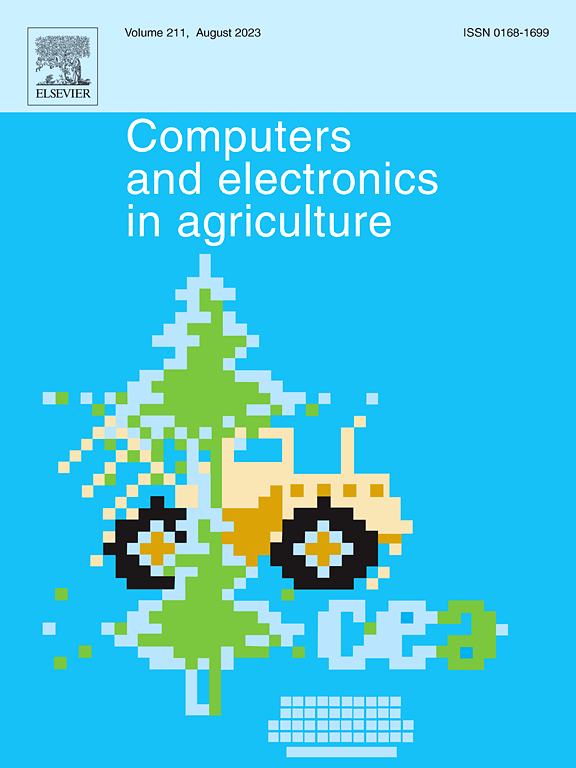Estimating water use efficiency in maize: a UAV-based approach integrating multisensory data with SEBAL evapotranspiration modeling
IF 8.9
1区 农林科学
Q1 AGRICULTURE, MULTIDISCIPLINARY
引用次数: 0
Abstract
Rapid, accurate, and non-destructive estimation of crop water use efficiency (WUE) at the field scale is crucial not only for evaluating water efficient cultivars and practices in scientific research but also for optimizing irrigation schedule in agricultural production. The current lack of efficient methods for high-throughput phenotyping WUE hinders development of sustainable agriculture under globally intensified water scarcity. This study aimed to utilize unmanned aerial vehicle (UAV) multisensory remote sensing data combined with a process model to achieve rapid WUE determination via accurate daily-scale evapotranspiration and aboveground biomass (AGB) estimates. First, vegetation indices, canopy temperature, and canopy structural parameters were extracted from multispectral (MS), thermal imaging (TIR), and radar data and combined with an automated machine learning (AutoML) for AGB estimation. The beta function was then employed to accurately estimate AGB accumulation at a daily step (AGBdaily) over the entire growth period. The daily evapotranspiration (ETdaily) was calculated by the surface energy balance algorithm for land (SEBAL) model driven by MS, TIR, and meteorological data. Finally, the WUE was determined by the ratio of AGBdaily to ETdaily. Multisensory data fusion and further integration with process-based model proved effective for simultaneously estimating AGBdaily, ETdaily, and WUE with R2 values of 0.71, 0.93, and 0.79, respectively. Notably, the proposed WUE estimation method can capture different temporal pattern between cultivars with different levels of tolerance to drought. We applied this approach to screen water efficient cultivars and found that appropriate reduction of irrigation can improve WUE. In conclusion, this study shows promising perspective in the use of a UAV-based approach integrating multisensory data with SEBAL evapotranspiration modeling for monitoring and evaluating water consumption and utilization in maize.
估算玉米水分利用效率:一种基于无人机的方法,将多感官数据与SEBAL蒸散模型相结合
在田间尺度上快速、准确、无损地估算作物水分利用效率,不仅对科学研究中评价节水品种和实践具有重要意义,而且对农业生产中优化灌溉计划也具有重要意义。目前缺乏高效的高通量水利用表型分析方法,阻碍了全球水资源短缺加剧下可持续农业的发展。本研究旨在利用无人机(UAV)多传感器遥感数据结合过程模型,通过精确的日尺度蒸散发和地上生物量(AGB)估算,实现快速确定WUE。首先,从多光谱(MS)、热成像(TIR)和雷达数据中提取植被指数、冠层温度和冠层结构参数,并结合自动机器学习(AutoML)进行AGB估计。然后利用beta函数准确估计整个生长期AGB的日累积量(AGBdaily)。利用MS、TIR和气象数据驱动的SEBAL模式计算日蒸散量(ETdaily)。最后,通过AGBdaily与ETdaily的比值确定WUE。多感官数据融合并与基于过程的模型进一步融合,可以同时估计AGBdaily、ETdaily和WUE, R2分别为0.71、0.93和0.79。值得注意的是,所提出的水分利用效率估算方法能够捕捉到不同耐旱性品种间不同的时间格局。利用该方法筛选节水品种,发现适当减少灌溉可以提高水分利用效率。综上所述,本研究显示了利用基于无人机的方法,将多感官数据与SEBAL蒸散发模型相结合,监测和评估玉米水分消耗和利用的前景。
本文章由计算机程序翻译,如有差异,请以英文原文为准。
求助全文
约1分钟内获得全文
求助全文
来源期刊

Computers and Electronics in Agriculture
工程技术-计算机:跨学科应用
CiteScore
15.30
自引率
14.50%
发文量
800
审稿时长
62 days
期刊介绍:
Computers and Electronics in Agriculture provides international coverage of advancements in computer hardware, software, electronic instrumentation, and control systems applied to agricultural challenges. Encompassing agronomy, horticulture, forestry, aquaculture, and animal farming, the journal publishes original papers, reviews, and applications notes. It explores the use of computers and electronics in plant or animal agricultural production, covering topics like agricultural soils, water, pests, controlled environments, and waste. The scope extends to on-farm post-harvest operations and relevant technologies, including artificial intelligence, sensors, machine vision, robotics, networking, and simulation modeling. Its companion journal, Smart Agricultural Technology, continues the focus on smart applications in production agriculture.
 求助内容:
求助内容: 应助结果提醒方式:
应助结果提醒方式:


